Oregon Gets the News
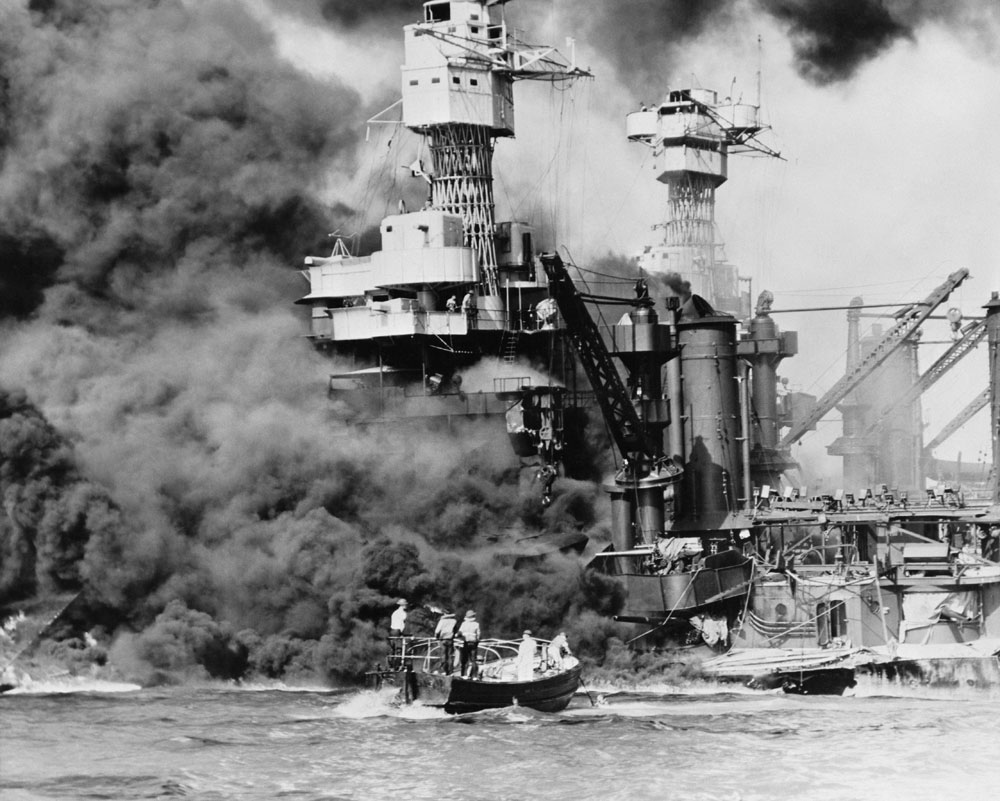 The
U.S.S. West Virginia in flames after the Japanese aerial attack on Pearl Harbor. (National Archives, image no. 80-G-19947)
Enlarge image of U.S.S. West Virginia.
The
U.S.S. West Virginia in flames after the Japanese aerial attack on Pearl Harbor. (National Archives, image no. 80-G-19947)
Enlarge image of U.S.S. West Virginia. Japanese bombs still were falling on Pearl Harbor as most Oregonians heard the news on the radio that quiet Sunday morning. Stories of the tragedy in Hawaii were relayed to the mainland by telephone, telegraph and teletype throughout the day. The United States government censored the news, refusing to release information about the number of ships sunk or the number of casualties, but Americans knew it was bad. In truth, the attack crippled the Navy's Pacific fleet, destroying five battleships and almost 200 planes while killing over 2,400 men. The size of the loss was devastating: the Navy lost three times as many men at Pearl Harbor as it had in the Spanish-American War and World War I combined. (
 Listen to a radio news report of the attack
Listen to a radio news report of the attack - via youtube.com)
Upon hearing the news of the bombing of Pearl Harbor, Oregonians shared feelings of shock, disbelief, fear, anger and sadness. The attack galvanized Americans, many of whom just a day earlier believed strongly in isolationism. The next day the United States declared war on Japan, triggering total American involvement not only in the Pacific but also in the war raging in Europe.
Sprague Responds
In Salem Governor Sprague quickly took action. In addition to being governor, he was the publisher of the Oregon
Statesman newspaper. The paper already had delivered the regular Sunday edition when the news broke. Sprague ordered all of the staff back to work to publish an "Extra" edition. An editorial on the front page braced the readers for the inevitable: "We are at war. Well, we have been at war before and have acquitted ourselves honorably. We will do so again. We are all Americans in this war of defense."
Footnote
1
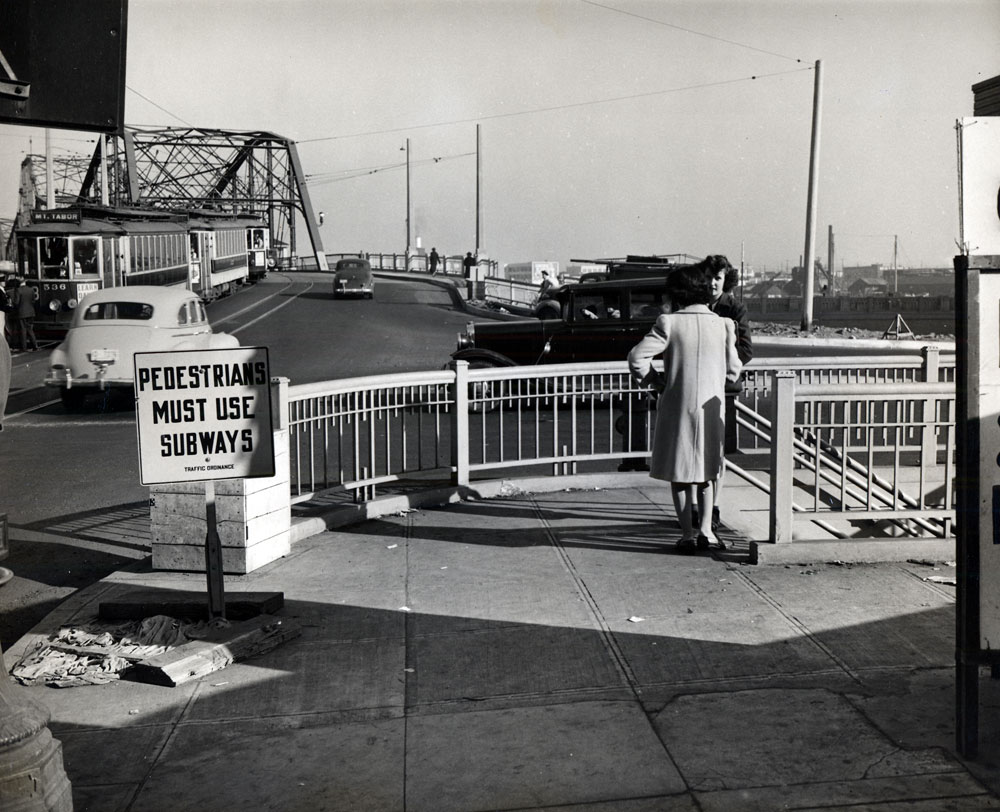 After the Pearl Harbor attack, guards patrolled Portland's bridges, such as the Morrison Bridge shown here in 1942. Bridges along the Coast Highway and the Pacific Highway also drew protection. (Photo no. 1945, Highway Dept. Records, OSA)
Enlarge image of Morrison Bridge.
After the Pearl Harbor attack, guards patrolled Portland's bridges, such as the Morrison Bridge shown here in 1942. Bridges along the Coast Highway and the Pacific Highway also drew protection. (Photo no. 1945, Highway Dept. Records, OSA)
Enlarge image of Morrison Bridge. The same day Sprague wired a message to President Franklin Roosevelt assuring "full support of the human and material resources of the State of Oregon." In a related statement, he called for vigilance against espionage and sabotage but interestingly made an appeal for the rights of Americans of Japanese descent who were living in Oregon: "...these Japanese-Americans who are citizens should not be molested." On Monday, December 8 Governor Sprague issued a proclamation declaring an "unlimited emergency" and outlining steps to coordinate military, law enforcement, and civilian defense organizations throughout the state.
"Portland Area Dons Full War Dress"
That was the headline of a front-page article in
The Oregonian newspaper the morning after the attack detailing plans to protect against air raids and invasion. By the morning after, Portland residents were coming to the "grim realization that the mouth of the Columbia river is the closest mainland point to Japan." Interceptor pursuit planes were dispersed to strategic fields in the region and all military leaves were cancelled. Guards were doubled around local military installations and airports and posted on bridges. Fifty soldiers from the Vancouver Barracks were dispatched to Portland's St. Johns area to guard docks and government stores. As in other coastal cities, officials rounded up certain Japanese citizens.
Footnote
2 Howard Nomura, a 31-year-old Portland Japanese American druggist, was resigned in the face of events: "...we know our lot is going to be a tough one. We can only rely on the fairness of the Caucasian Americans to help us through."
Footnote
3
According to one reporter at
The Oregonian, future notable University of Oregon History Professor Earl Pomeroy, Portland residents quickly overcame the shock of the attack: "There was no hysteria. There were no demonstrations. But there was emotion - a mounting anger born of the conditions under which the United States had been attacked, a gnawing kind of anger which found release in fervently expressed desire for full vengeance."
Footnote
4The Nation Goes to War
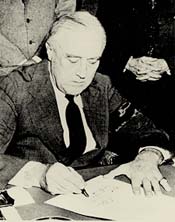 President Roosevelt signs the declaration of war against Japan. National Archives, image no. 79-AR-82
President Roosevelt signs the declaration of war against Japan. National Archives, image no. 79-AR-82
The day of the attack, national leaders moved to action as they recovered from the stunning events. America's 2.1 million member armed forces were put on emergency alert. Machine gun emplacements were set up on the roof of the White House. An airplane was kept running at a secret airstrip on the edge of Washington D.C. so President Roosevelt could be quickly evacuated. But the challenges of protecting the city and the nation were symbolized by the soldiers who quickly took up posts at government buildings in Washington D.C. They wore World War I vintage helmets and carried the old Springfield rifles from the last war.
Footnote
5
The next day Roosevelt addressed a joint session of Congress. A record radio audience of 60 million listened as the president proclaimed that "Yesterday, December 7, 1941, a date which will live in infamy, the United States was suddenly and deliberately attacked by naval and air forces of the Empire of Japan."
 Declarations of a State of War
Footnote
6
Declarations of a State of War
Footnote
6
Roosevelt finished his speech by asking Congress to declare war on Japan. (
 Watch the speech
Watch the speech - via youtube.com) The Capitol erupted in applause and within an hour Congress had obliged the Senate by a vote of 82-0. Soon after war was declared on Germany and Italy.
Willamette Football Team Stranded in Hawaii
When news of the attack on Pearl Harbor was broadcast on radio Sunday, some of the first fears for Oregonians were for the Willamette University football team and fans in Honolulu. They had traveled to Hawaii for a series of post season games known as the Shrine Bowl against the University of Hawaii and San Jose State. The first game was played Dec. 6 before a crowd of 24,000. Although the Bearcats suffered a 20-6 defeat, many were looking forward to several days of post-game festivities. The Willamette team and fans from Salem were waiting outside the Moana Hotel for a bus to take them on a sightseeing tour. They also were planning to see Pearl Harbor. As black oily smoke filled the air the team and their supporters realized that they were witnesses to a terrible and momentous event.
Stranded in Hawaii
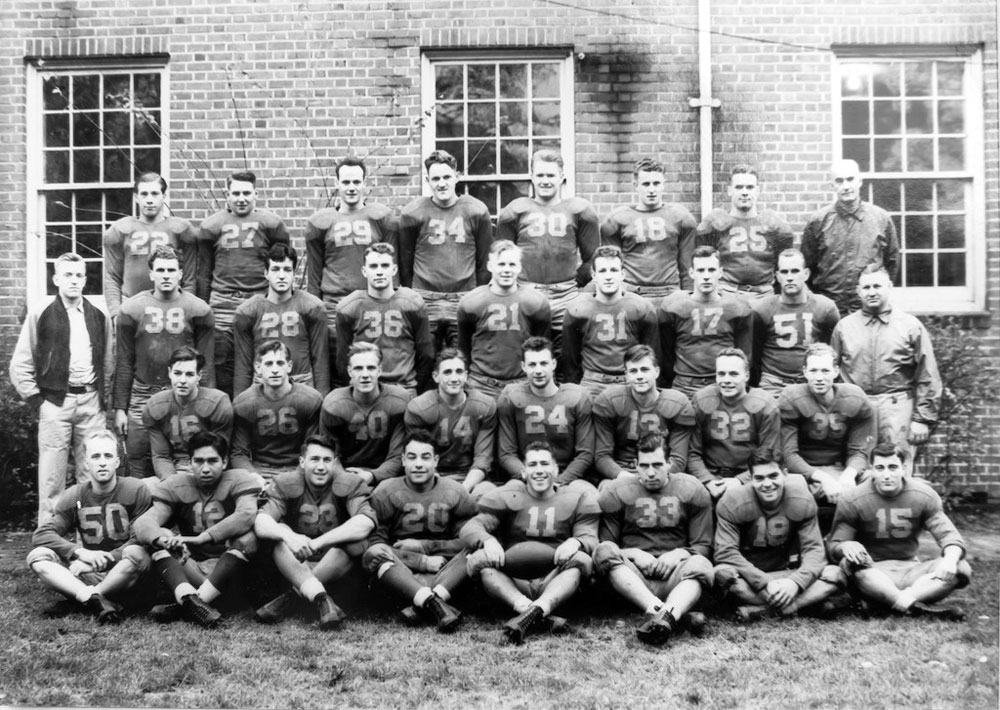 The Willamette University football team was stranded in Hawaii after the attack on Pearl Harbor. It took weeks to get back to the mainland.(Image courtesy Willamette University)
Enlarge image of football team. The 1941 Willamette University Bearcats: (front row, from left): Irv Miller, Cecil Conner, Pat White, Tony Fraiola, Al Walden, Jim Fitzgerald, Buddy Reynolds, Chuck Furno, (second row from left) Earl Hampton, Bill Reder, Martin Barstad, Ted Ogdahl, Jim Burgess, Gene Stewart, Glenn Nordquist, Wally Olson; (third row from left) Dick Kern (manager), Paul Cookingham, George Constable, David Kelly, Ken Jacobson, Allan Barrett, Marshall Barbour, Clarence Williams, Assistant Coach Howard Maple; (back row from left) David Kurtz, Robert Bennett, Gordon Moore, Andrew Rogers, Neil Morley, Marv Goodman, Carrel "Truck" Deiner, Coach Roy S. "Spec" Keene. Note: Kurtz, Clarence Walden and coach Maple did not make the trip to Hawaii.
The Willamette University football team was stranded in Hawaii after the attack on Pearl Harbor. It took weeks to get back to the mainland.(Image courtesy Willamette University)
Enlarge image of football team. The 1941 Willamette University Bearcats: (front row, from left): Irv Miller, Cecil Conner, Pat White, Tony Fraiola, Al Walden, Jim Fitzgerald, Buddy Reynolds, Chuck Furno, (second row from left) Earl Hampton, Bill Reder, Martin Barstad, Ted Ogdahl, Jim Burgess, Gene Stewart, Glenn Nordquist, Wally Olson; (third row from left) Dick Kern (manager), Paul Cookingham, George Constable, David Kelly, Ken Jacobson, Allan Barrett, Marshall Barbour, Clarence Williams, Assistant Coach Howard Maple; (back row from left) David Kurtz, Robert Bennett, Gordon Moore, Andrew Rogers, Neil Morley, Marv Goodman, Carrel "Truck" Deiner, Coach Roy S. "Spec" Keene. Note: Kurtz, Clarence Walden and coach Maple did not make the trip to Hawaii.
After the devastating attack the football team was enlisted by the Army to fend off a possible Japanese invasion by water. Their first set of orders was to string barbed wire on Waikiki Beach at low tide. The players were issued bolt-action Springfield rifles from World War I and given brief training before being told to be prepared to defend the beach. Shortly after they were assigned to Punahou High School in the hills above Honolulu. Authorities feared that water towers and storage tanks nearby might be targets of sabotage. The players moved into the dormitories and class rooms and went on sentry rotation.
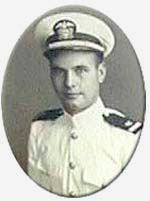 Delmore "Verdi" Sederstrom, one of at least 17 Oregonians to die during the Pearl Harbor attack, later had a ship commissioned in his name. (OSA image)
Delmore "Verdi" Sederstrom, one of at least 17 Oregonians to die during the Pearl Harbor attack, later had a ship commissioned in his name. (OSA image) Foremost in everyone's minds were the questions of how and when they would get home. They finally left Hawaii December 19 aboard the
SS President Coolidge. A luxury ocean liner, the Coolidge had arrived in Hawaii with evacuees from the Philippines. It was commandeered to transport gravely wounded servicemen. Roy "Spec" Keene, the Willamette coach, and Douglas McKay, a state senator and future governor traveling with the team, persuaded the captain to take the team and their followers back to the mainland in exchange for assisting with the wounded. There were approximately 1,200 people on board the ship that was designed to carry 800. The normal four-day trip took seven days because of the zigzagging route required to avoid Japanese submarines. On Christmas Day the Willamette football party finally returned safely to San Francisco. It was the last time they would all be together.
Footnote
7 Offers of Help Roll In
Offers of help and advice came from around the state in the days after the Pearl Harbor attack. The Oregon Congress of Parents and Teachers wrote to Sprague to offer the services of its 364 local associations totaling 25,618 members. The congress president noted all members could be contacted within 24 hours and stood ready to "help make Oregon safe."
Footnote
8 Oregon chiropodists pledged support while proclaiming: "We know there is some place where we would fit in."
Footnote
9 And World War I veteran Alfred Steele of Holland, Oregon offered his "services for the duration in whatever capacity you may choose."
 Letter from Alfred Steele
Letter from Alfred Steele
"I will go anywhere, do anything, in order to do my bit."Footnote
10
Organized labor, known for its bitter strikes, also got on board. The 1,400 members of Locals 1-8 of the Longshoremen's and Warehousemen's Union in Portland pledged "support and full cooperation mentally, physically, and financially" to the effort. They further promised to "prevent any stoppage of work in this business until the very end...to safe-guard this port of Portland and the nation as a whole in this National emergency."
Footnote
11 Members of the International Woodworkers of America in Westfir "voted 100 percent to aid in the national defense in any way possible."
Footnote
12
Some unions sent resolutions offering their support, albeit prefaced by sharp rhetoric. The IWA-CIO union in Dorena adopted a resolution claiming that: "labor will carry its bitter recollections of...vigilantes committees, of sundry clubbings and shootings...of Jim Crowism and Lynch law and relief lines, but whatever fires of resentment may still burn at memories such as these, they fade into feeble embers in the fierce light of a world in flames.... Be it resolved that the IWA-CIO Local Union No. 5-248 go on record pledging all-out on a new picket line, a picket line against universal terrorism...."
 Resolution of the IWA-CIO Union in DorenaFootnote
13
Resolution of the IWA-CIO Union in DorenaFootnote
13Related Document
 Telegram from Jack Helms to Jerrold Owen Urging State of Emergency Declaration, Dec. 7, 1941. Folder 4 , Box 32, Defense Council Records, OSA.
Telegram from Jack Helms to Jerrold Owen Urging State of Emergency Declaration, Dec. 7, 1941. Folder 4 , Box 32, Defense Council Records, OSA.
Notes